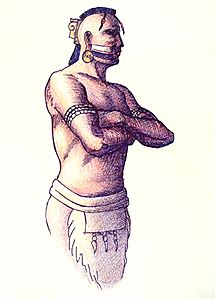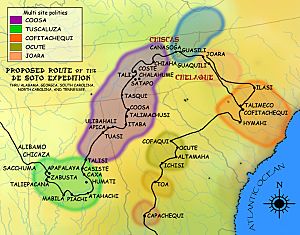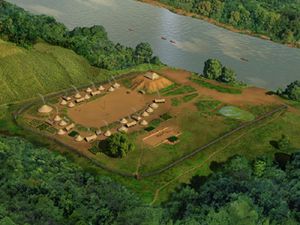Tuskaloosa facts for kids
Quick facts for kids
Tuskaloosa
|
|
|---|---|

Chief Tuskaloosa. Illustration by H. Roe
|
|
| Died | 1540 |
| Title | Cacique (Chief) of Tuskalusa |
Tuskaloosa (also spelled Tuskalusa, Tastaluca, or Tuskaluza) was a powerful Native American leader who lived in what is now the state of Alabama. He was a paramount chief, meaning he was the main leader of a large group of villages. His people belonged to the Mississippian culture, known for building large mounds.
Historians believe Tuskaloosa's people might be the ancestors of today's Choctaw and Creek Native American groups. The modern city of Tuscaloosa, Alabama, is named after him. We don't know when Tuskaloosa was born. Records from that time describe him as a very tall and strong man. Some writers even said he was much taller than the Spanish explorers. His name means "Black Warrior" in the Muskogean language.
[Tuskaloosa]'s appearance was full of dignity he was tall of person, muscular, lean, and symmetrical. He was the suzerain of many territories, and of numerous people, being equally feared by his vassals and the neighbouring nations.
—Gentleman of Elvas - Narratives of the Career of Hernando De Soto in the Conquest of Florida , 1557
Tuskaloosa is famous for leading a major battle against the Spanish explorer Hernando de Soto. This fight, called the Battle of Mabila, happened at Tuskaloosa's fortified village. The Spanish had taken Tuskaloosa hostage as they traveled through his lands. But Tuskaloosa planned a surprise attack on his captors. Even though his people fought bravely, they were eventually defeated.
Contents
Hernando de Soto's Journey to North America
The story of Tuskaloosa and his people comes from the writings of Hernando de Soto's expedition. De Soto arrived in North America in 1539. The King of Spain had made him Governor of Cuba. His mission was to conquer a large area called "Florida," which included much of what is now the Southern United States.
In 1539, de Soto landed in Tampa, Florida, with a large group of soldiers and horses. He began exploring modern-day Florida, Georgia, South Carolina, and Alabama. His group often had violent fights with the Native American people they met.
As they traveled, the Spanish kidnapped Native Americans. They forced them to carry supplies and to act as interpreters. These interpreters helped them speak with different tribes. The Spanish often took a local chief hostage. This was to make sure they could travel safely through the chief's territory. By October 1540, de Soto's group had reached the middle of modern-day Alabama.
Tuskaloosa's Territory and People

Tuskaloosa's territory included many villages. Most of these villages were located along the Coosa and Alabama rivers. Each village had its own chief. These local chiefs were loyal to Tuskaloosa, who was the main paramount chief.
On September 18, 1540, de Soto's group reached a village called Talisi. This village was near where the modern town of Childersburg, Alabama is today. The chief of Talisi had run away before the Spanish arrived. But de Soto sent messages, and the chief returned on September 25.
The chief of Talisi showed his loyalty by giving the Spanish deerskins, food, and people to carry their supplies. After this, de Soto released the chief of Coosa. The Spanish had held the Coosa chief hostage while traveling through his land. The Coosa chief was upset because he was taken far from home. De Soto also still held his sister. She was likely important for choosing the next chief, as the tribe followed a matrilineal system.
Tuskaloosa sent his son and other important men to meet the Spanish in Talisi. This group was sent to check out the Spanish expedition. They wanted to plan a trap for them. The Spanish stayed in Talisi for several weeks. Then, they left on October 5. Over the next few days, they reached a new village in Tuskaloosa's territory almost every day.
On October 9, de Soto crossed the Tallapoosa River. By the end of the day, his group was very close to Tuskaloosa's main village, Atahachi.
De Soto sent a messenger to tell Tuskaloosa that they had arrived. The chief replied that de Soto could come to his court whenever he wanted. The next day, de Soto sent Luis de Moscoso Alvarado to tell the chief they were on their way. Atahachi was a large, recently built village. It had strong defenses, a platform mound, and a central plaza. When de Soto entered the village, he was taken to meet the chief on top of the mound.
Chapter VII-In which is related what happened to the commander Hernando de Soto, in his intercourse with the Chief of Tascaluza...who was such a tall man that he seemed a giant: Sunday, October 10, 1540, the Governor entered the village of Tascaluça, which is called Athahachi, a recent village. And the chief was on a kind of balcony on a mound at one side of the square, his head covered by a kind of coif like the almaizal, so that his headdress was like a Moor's which gave him an aspect of authority; he also wore a pelote or mantle of feathers down to his feet, very imposing; he was seated on some high cushions, and many of the principal men among his Indians were with him. He was as tall as that Tony (Antonico) of the Emperor, our lord's guard, and well proportioned, a fine and comely figure of a man. He had a son, a young man as tall as himself but more slender. Before this chief there stood always an Indian of graceful mien holding a parasol on a handle something like a round and very large fly fan, with a cross similar to that of the Knights of the Order of St. John of Rhodes, in the middle of a black field, and the cross was white. And although the Governor entered the plaza and alighted from his horse and went up to him, he did not rise, but remained passive in perfect composure and as if he had been a king.
—Rodrigo Ranjel 1544
Moscoso and his men rode their horses around the plaza. They played a dangerous game called juego de cañas, which involved jousting with lances. Sometimes, they pretended to charge at Tuskaloosa. They hoped to scare him, a trick de Soto had used before. But the chief remained calm and did not move. Afterward, the Native Americans gave the Spanish food. The people of Atahachi danced in the plaza. This reminded the Spanish of dances in their own country.
De Soto then demanded that Tuskaloosa provide people to carry their supplies and women. Tuskaloosa replied that he was used to being served, not serving others. De Soto then took Tuskaloosa hostage. The Spanish planned to leave the next day. Tuskaloosa finally agreed to provide bearers for the Spanish. He told de Soto that they would have to go to his town of Mabila to get the women. De Soto gave the chief a pair of boots and a red cloak as a reward.
The expedition left Atachaci on October 12. The next day, they arrived in the village of Piachi. This village was high on a cliff overlooking the Alabama River. Here, the Spanish started to notice signs that the Native Americans were preparing to resist. De Soto asked the people of Piachi for canoes. But the chief claimed his people had none. The expedition had to wait two days to build rafts to cross the river.
After crossing, they realized two Spanish men were missing. De Soto ordered Tuskaloosa to make his people return the men. If not, he would be burned. The chief only said the men would be returned at Mabila.
On October 18, de Soto and his group arrived at Mabila. This was a small, very well-protected village on a flat plain. It had a strong wooden palisade (a fence of tall stakes) all around it. There were also bastions, which were strong points for archers to shoot from. The Spanish realized something was wrong. The town was mostly filled with young male warriors and important men. There were some women, but no children. The Spanish also saw that the palisade had been recently made stronger. All trees, bushes, and even weeds had been cleared from outside the village. This was done for a long distance, about the length of a crossbow shot. Outside the palisade, they saw an older warrior training younger men.
Archaeological Discoveries
Archaeologists have studied the Big Eddy phase of the South Appalachian Mississippian culture. They believe this phase might be the "Province of Tuskaloosa" that de Soto found in 1540. The Taskigi Mound is a platform mound and a fortified village site. It is located where the Coosa, Tallapoosa, and Alabama Rivers meet, near Wetumpka, Alabama. This site is now part of the Fort Toulouse-Fort Jackson State Historic Site. It is also on the University of Alabama Museums "Alabama Indigenous Mound Trail."
The Battle of Mabila
As de Soto got close to Mabila, the chief of Mabila came out to greet him. He brought de Soto three robes made of marten skins as a gift. De Soto and some of his men got off their horses and went into the town. The Native American bearers placed the Spanish supplies next to the palisade. The Mabilians danced and sang for the Spanish. This seemed to calm their fears and distract them.
While this was happening, Tuskaloosa told de Soto he was tired of marching with the Spanish. He wanted to stay in Mabila. De Soto refused. The chief then asked to talk with some of his nobles in one of the large wattle and daub houses in the plaza. De Soto sent Juan Ortiz to get him, but the Mabilians would not let him into the house. Tuskaloosa then told de Soto and his group to leave peacefully. If not, he and his allies would force them to leave.
When de Soto sent men into the house to get the chief, they found it full of armed warriors. These warriors were ready to protect their chief. De Soto asked the Chief of Mabila to provide the people Tuskaloosa had promised. He said the Spanish would then leave. The Mabila chief refused. A Spanish soldier grabbed him. In the fight that followed, the chief had his arm cut off by the Spaniard's sword.
With this, the Mabilians attacked the Spanish. The Spanish immediately ran for the gate and their horses. Native Americans came out of all the houses and attacked the Spanish. The Mabilians grabbed the supplies and equipment left outside the palisade. They brought these supplies into the town. After getting outside, the Spanish regrouped. They then attacked the village. After many attacks and several hours of fighting (the battle lasted eight or nine hours), the Spanish managed to break holes in the palisade walls. They then re-entered the town.
We entered the town and set it on fire, whereby a number of Indians were burned, and all that we had was consumed, so that there remained not a thing. We fought that day until nightfall, without a single Indian having surrendered to us- they fighting bravely on like lions. We killed them all, either with fire or the sword, or, such of them as came out, with the lance, so that when it was nearly dark there remained only three alive; and these, taking the women that had been brought to dance, placed the twenty in front, who, crossing their hands, made signs to us that we should come for them. The Christians advancing toward the women, these turned aside, and the three men behind them shot their arrows at us, when we killed two of them. The last Indian died.
—Luys Biedma 1544
After the Battle of Mabila
Impact on the Mabilians
The Spanish burned Mabila to the ground. Almost all the Mabilians and their allies were killed. They died either in the battle or in the fires that followed. Chief Tuskaloosa's son was found among the dead. However, the chief himself was not found. One Spanish writer, Biedma, said that over five thousand people were in the town. Almost none of them managed to escape.
For several weeks after the battle, the Spanish searched nearby villages. They looked for supplies like maize (corn) and deerskins. They found many wounded and dead Mabilians in the houses. The Native Americans had made two big mistakes. They did not realize how strong the Spanish were when fighting on horses. Also, they relied too much on their palisade. Once the Spanish broke through the palisade, the Mabilians were too crowded inside the village to defend themselves well.
Over the next few centuries, different Native American groups came together. These included the Tuskaloosa, Coosa, and Plaquemine people from the Mississippi and Pearl River valleys. They formed a large group that became the historic tribe known as the Choctaw.
Images for kids
-
A map showing the de Soto expedition route through Georgia, South Carolina, North Carolina, Tennessee, and Alabama. Based on Charles M. Hudson's map







